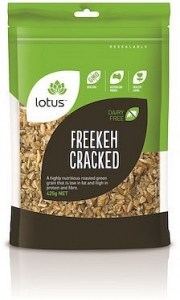
Freekeh

Freekeh (pronounced free-kah) is an ancient super grain made from durum wheat that’s been harvested while still young and green. It’s then roasted and rubbed to remove the grain resulting in its distinct nutty and slight smokey flavour.
Freekeh is a popular grain used in middle eastern cuisine. It gets its name from the process in which this highly nutritious grain is created. Durum wheat is harvested while still green, roasted then taken through a rubbing process traditionally called farikor (freekeh) meaning “rubbed”.
Freekeh is low in calories and high in protein, fibre and a host of essential minerals including iron and magnesium. These nutrients are retained thanks to the early harvest of the green wheat.
Benefits of Freekeh
Freekeh is one of the most nutritious ancient grains around, rivalling many whole grain favourites like quinoa, brown rice, and oats in the nutrition stakes. Adding this ancient grain to meals to reap its benefits is easy, with cooked freekeh popular as a side dish with middle eastern fare or adding 1 cup to salads, porridge, or as a base for poke bowls.
Protein for strong muscles: Proteins are the building blocks for muscles in the body, and with close to 15g of protein per 100g freekeh this nutritious grain is a great choice for anyone looking for high-protein foods. Specifically, the amino acid glutamic acid is high in freekeh with approx 2g per serve. It is responsible for synthesising glutamine aiding in strength and endurance building.
Helps aid digestion and support the digestive tract: Freekeh is high in fibre, with about 13g per 100g. Fibre can help support a healthy digestive system, with the insoluble fibre content of freekeh adding bulk to assist the digestive system.
With prebiotics, which help promote bacteria in the intestines, freekeh may be beneficial for sufferers of IBS with studies suggest foods containing prebiotics may be helpful in reducing symptoms.
Promotes healthy weight control: Thanks to its high protein and fibre content freekeh supports satiety as part of a healthy meal and may be beneficial in promoting healthy weight control. Compared to other fibre- and protein-rich whole grains, freekeh has more fibre and protein than both brown rice and quinoa.
Top Selling Freekeh
Nutrition
As a whole grain Freekeh is not suitable for gluten-free diets, however Freekeh is an incredibly nutritious grain. With impressive levels of essential minerals - including iron, zinc, and copper - as well as an array of vitamins, and gut friendly prebiotics it stands up well against other grains and seeds in the nutrition stakes. Along with probiotics, prebiotics are essential for good gut health. Prebiotics help good bacteria thrive in the body’s digestive tract, supporting good digestion. This alone makes Freekeh a popular choice for health goers looking for a nutritious option that goes above and beyond the run of the mill nutrition profile of other grains.
Considered an excellent source of protein and fibre, Freekeh also boasts a low glycemic index and fat content. Due its ability to transition quickly through the body’s digestive tract, it’s also been touted as an excellent grain to help maintain a healthy weight while promoting a healthy bowel.
Nutrients per serving ( about 3/4 cup cooked )
| Calories: | 170 |
| Carbs: | 33g |
| Protein: | 7g |
| Fibre: | 8g |
| Fat: | 1.5g |
| Sugar: | 1g |
| Calcium: | 20mg |
| Iron: | 1.8mg |
| Magnesium: | 40mg |
How to use Freekeh
Freekeh is a very versatile grain, easily lending itself to both sweet and savoury dishes. With recipes ranging from spruced up porridges, soups, to salads, you’re only limited by your imagination when incorporating this delicious ancient grain into your diet.
Cook and stir in a simple dressing of olive oil and lemon juice for a side dish you’ll want to recreate again and again, use it as a base to make buddha bowls, or try something a little different with this delicious-looking Freekeh Omelette for a nutrient-packed breakfast.
FAQ:
Is Freekeh healthier than rice?
Nutritionally speaking Freekeh is superior to rice. Compared to brown rice, freekeh has less calories, twice the amount of protein, close to four times the amount of fibre, less carbohydrates and fat, as well as three times more iron than brown rice.
What does it taste like?
Freekeh has a taste like no other grain around. Due to the unusual way in which freekeh is made (roasting green wheat then rubbing the grain to reveal the whole grain version of freekeh) it’s left with a nutty and lightly smoked flavour. It’s also quite dense, with a slightly chewy texture.
Is Freekeh good for you?
With an impressive list of nutrients, Freekeh is fast becoming a popular choice for health-goers. As you can see from the nutrition profile above, Freekeh is packed with vitamins, essential minerals, protein, fibre, and other good-for-you nutrients. And since it’s considered to have prebiotics, freekeh is ideal for helping to promote good gut bacteria to support digestive health.
Is Freekeh gluten free?
No, Freekeh is not gluten free. Freekeh is made from a type of wheat, which contains the protein anyone following a gluten-free diet due to sensitivity or intolerance needs to avoid.
What is freekeh made of?
Freekeh (pronounced free-kah) is an ancient grain made from durum wheat that has been harvested when the grain is still green. The green wheat is then roasted and the grain rubbed off the wheat. This results in whole grain Freekeh, not to be confused with the cracked freekeh most commonly found in health food stores and supermarkets. Cracked freekeh is basically just the whole grain crushed into smaller pieces, which allows it to cook faster.
How to cook freekeh?
It’s easy to cook Freekeh, with the most popular way following a method similar to that of cooking quinoa and rice by boiling it on a low heat until excess water has been absorbed. For perfectly cooked Freekeh follow a ratio of 2 1/2 cups of water or stock to 1 cup of freekeh, letting it simmer on low for approximately 20-25 minutes or until the excess water has been absorbed. This will yield approximately 3-4 cups of cooked freekeh. Preparing it this way makes for the perfect side dish with middle eastern cuisine, or it can be stirred through salads for extra nutrition and satiety.

Lotus Freekeh Whole 425g
When the young seeds of green wheat are harvested and processed correctly, they’re known as freekeh. The cooked grain has a crunchy texture and a more noticeable nutty taste than regular wheat. It’s versatile enough to be used alone as a rice substitute, in stews as a barley substitute, or as a welcome addition to many salads.
Ingredients: Freekeh
Shop nowFreekeh is an incredibly nutritious ancient grain regularly used in middle eastern cuisine. Although it’s not a good option for those following a gluten-free diet other health goers will be pleasantly surprised by the nutrient content and yummy taste of this ancient supergrain.
Although relatively new to the health scene it is fast becoming a popular alternative to brown rice, quinoa, oats, couscous and others due to its superior nutrition profile. It’s an excellent choice for anyone looking for a high protein, fibre-packed whole grain, with the added benefit of prebiotics for gut health.
Boasting a unique flavour profile that’s slightly smokey and nutty, and with a delightfully chewy texture, it adds a little something extra to everything from salads, porridges, and soups to being a star side dish all on its own. So if you’re a bit bored of quinoa and can’t bring yourself to boil yet another pot of brown rice, this ancient grain is an excellent alternative.





